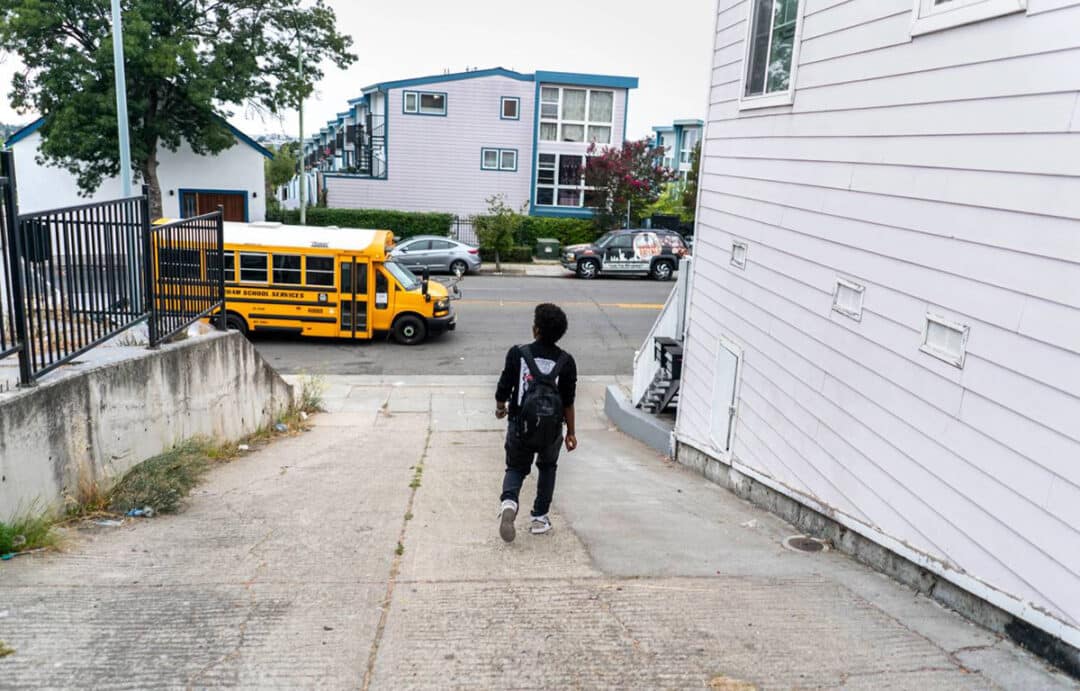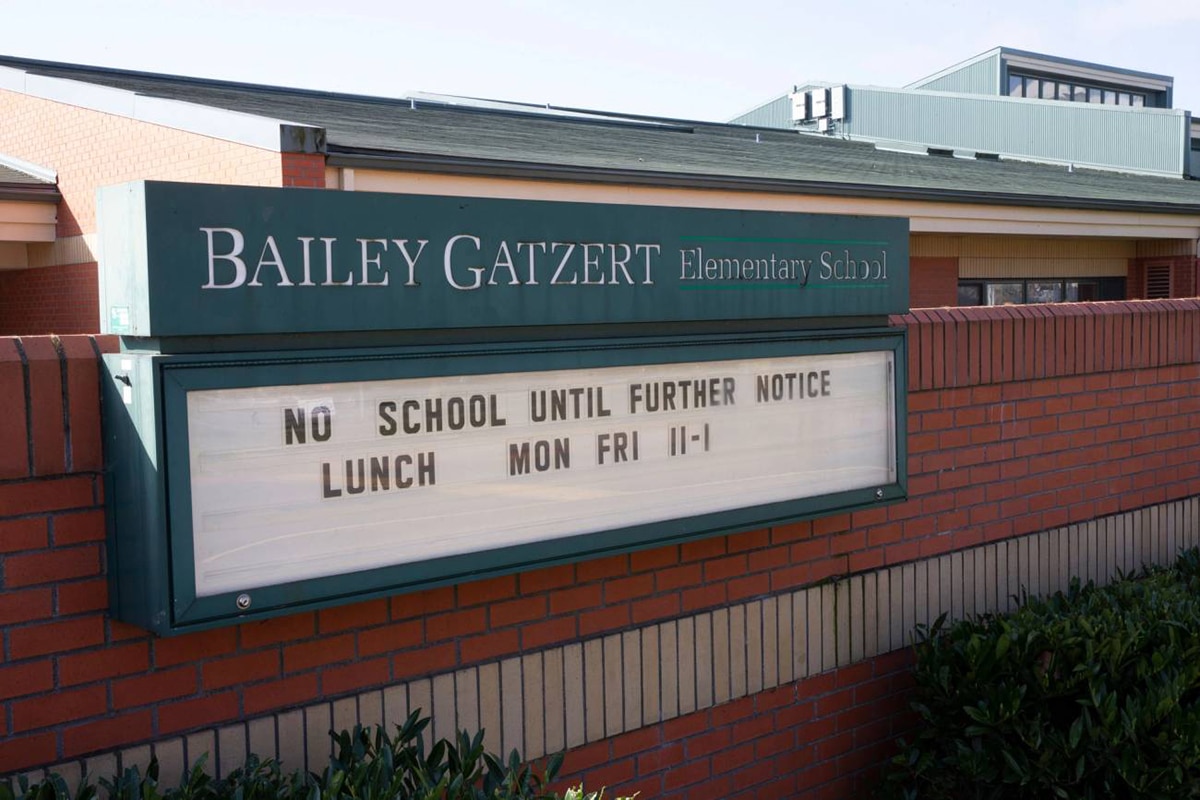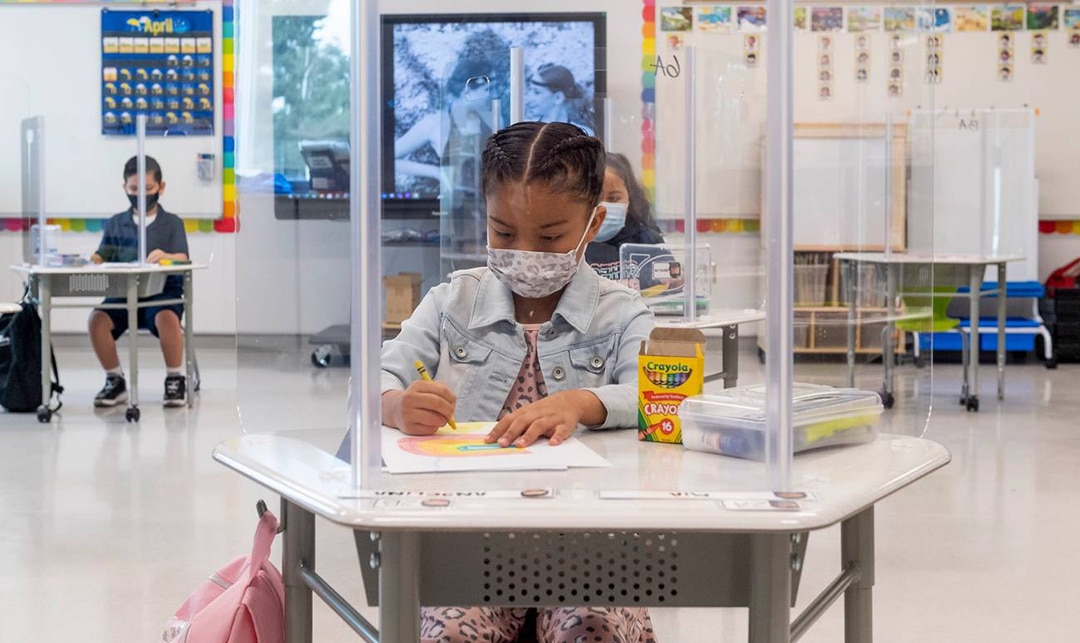

A boy walking to a catch a public bus to his high school in Oakland, CaliforniaMELINA MARA/THE WASHINGTON POST VIA GETTY IMAGES
How the Teachers Union Broke Public Education
On May 17, the Oakland, California, teachers union ended a two-week strike—the union’s third strike in five years. The district offered a substantial salary increase for teachers before the strike even began, but negotiations remained deadlocked for days over the union’s other demands. The Oakland Education Association (OEA) put forward several “common good” proposals that included drought-resistant shrubs, a Climate Justice Day, reparations for Black students, and converting unused school and office buildings into housing for homeless kids and their families.
Most of these “common good” issues were outside the legal scope of teachers’ contracts, but as The Wall Street Journal editorial board pointed out, OEA is not a rogue branch of the teachers union. The National Education Association (NEA)—the largest labor union in the U.S. representing teachers and other school faculty—explicitly tells teachers to bargain for the “common good,” advising union branches that, “When we expand the continuum of bargaining, we build power, and go on the offense in order to fight for social and racial justice.”
What makes the NEA’s bargaining approach so remarkable is the fact that this union and its counterpart, the American Federation of Teachers (AFT), have recently inflicted profound racial and social injustice on the country’s school children in the form of extended school closures.
As an Oakland public school teacher, I was a staunch supporter of the teachers union and was a union representative at my school for three years. In 2020, however, I began to disagree with the union when it prevented me from returning to my classroom long after studies proved that school reopening was safe, even without COVID-19 mitigation measures. In my experience, the union’s actions were not motivated by sincere fears, but rather by a desire to virtue-signal and maintain comfortable work-from-home conditions.
Although union bosses like Randi Weingarten continue to obfuscate their role in school closures, the historical record is clear: The union repeatedly pushed to keep schools closed, and areas with greater union influence kept schools closed longer. Politicians, public health officials, and the media certainly had a hand in this fiasco, but the union egged on dramatic news stories, framed school reopening as a partisan issue, and directly interfered in CDC recommendations. Teachers saw firsthand that virtual learning was a farce and that children were suffering. While there may be plenty of blame to go around, teachers’ abandonment of their own students was a special kind of betrayal.
I am well aware that there were many problems plaguing public education before school closures, and that teaching was a challenging and exhausting job. Today, however, the crisis teachers face is an order of magnitude worse than it was in 2019, and this crisis is almost entirely self-inflicted. Public school enrollment is plummeting, kids are refusing to go to school, and disciplinary problems are spiraling out of control.
Many districts are in freefall. In Baltimore, one high school student told the local news that, “The rising number of violence within city public schools has been unfathomable.” More than 80% of U.S. schools have reported an increase in behavior issues. Nearly half of all schools have teacher shortages, and teachers continue to leave in droves.
Nationally, the chronic absence rate doubled, and it is not showing signs of improvement. In one San Francisco elementary school, almost 90% of students were chronically absent in the 2021-22 school year. In New York City, 50% of all Black students and 47% of all Latino students were chronically absent. Parents have no idea how far behind their kids really are, and schools cannot repair learning loss on a mass scale because the available workforce is simply not up to the task.
School closures were a yearlong exercise in anti-solidarity.
What happened in 2020 was the result of a long process in which the union replaced labor-related goals, which are finite and measurable, with activism, which is infinite and abstract. In 2018, a group of West Virginia teachers kicked off a national teachers strike wave. Most of these strikes had reasonable goals and broad public support, but, like all social movements, this strike wave gave birth to insatiable fanaticism.
In his 1951 book The True Believer: Thoughts on the Nature of Mass Movements, Eric Hoffer explained, “The danger of the fanatic to the development of a movement is that he cannot settle down … The taste for strong feeling drives him on to search for mysteries yet to be revealed and secret doors yet to be opened. He keeps groping for extremes.” The teachers union may have once had noble intentions, but these intentions have been hijacked by histrionic fanatics whose thirst for extremes might have contributed to the deaths of thousands of children and teenagers.
Although it still has the veneer of a labor organization, the teachers union is an activist arm of the Democratic Party. Since 2016, progressive leaders of the AFT and the NEA have increasingly prioritized political causes like Black Lives Matter and their opposition to Donald Trump. What’s more, external elements have also parasitized the union for their own objectives. For several years, left-wing publications and organizations pressured the teachers union to embrace social justice goals unrelated to those of traditional organized labor. The Democratic Socialists of America (an organization mostly composed of college-educated millennials) even made open attempts to infiltrate and influence the union.
At one time, the teachers proudly viewed education as an engine of social mobility. Today, the union is a captured institution, and it argues that the country must be remade for education to even be possible. Favoring ideological indoctrination over academic achievement fundamentally devalues teaching and learning. It is this devaluing that was the nail in the coffin for the school system.
Public education itself is one of the most important “common goods” there is, and treating it as “nonessential” has had profound consequences. Kids feeling depressed, not wanting to go to school, and misbehaving when they get there is a natural response to the message adults have sent them. There were many forces that made public education so fragile to begin with, but it was the teachers union that dealt the final blow.
In 2020 and 2021, like many other sectors of society, the teachers union lost the capacity for moral reasoning and developed a monomaniacal obsession with “safety.” The sentiment expressed in the infamous Chicago teachers union tweet (“The drive to reopen schools is rooted in racism, sexism, and misogyny”) exemplified the degree of hysteria in large, urban school districts. Ignoring the clear harm they were doing to children, union leaders made increasingly cruel, hypocritical, and illogical decisions.
School closures were a yearlong exercise in anti-solidarity. Teachers expected essential workers to deliver food for them, pick up their trash, and literally keep the lights on—all while the union withheld real education from these workers’ children. In July 2020, I offered to return to teach students with severe disabilities in person, but a union leader told me no teachers could go back. To provide federally mandated special education services, the school district hired a private agency to go house to house for some students, which was supposedly safer than allowing me to teach them in small groups outside. Despite the union’s claim of doing something righteous, it had simply displaced the “risk” of teaching onto a private contractor.
In early 2021, the district also set up after-school pods for some special education students, but teachers like me were not allowed to supervise them, so the district used low-wage aides to staff the pods. Again, the teachers union displaced “risk”—this time onto underpaid workers. At my school’s union meeting, teachers complained about the fact that small groups of disabled students were now coming to campus for a few hours a week, citing their concerns about “safety protocols,” even though these teachers were still working remotely.
When I set up my own small, in-person literacy group for students whose parents wanted it, I tried to keep it secret from my colleagues. A union representative called me, and she told me that seeing any kid in person would make the community “unsafe.” If I did this, she said, it would be equivalent to crossing a picket line. At this time, private schools in California were open, and public schools had been open for many months in Europe and other U.S. states.
During my school’s union meeting in April 2021, when we were finally about to go back to work in person, some teachers threatened to call parents and tell them not to send their kids back to school because it was still “unsafe.” This was after all of my colleagues had skipped the line to get vaccinated early.
In the fall of 2021, the Oakland union supported a vaccine mandate for students that would have pushed 3,000 unvaccinated kids back into online learning (40% of whom were Black). Later that school year, Oakland teachers staged a “sick out” to demand N95 masks, and at the behest of the union, Oakland schools maintained an indoor and outdoor mask mandate until April 2022. On the Instagram page of my old school, which serves low-income students of color, about half of all the kids and staff pictured this year were still wearing masks, even in April 2023.
The union’s fixation on “safety” was a mania that amounted to the psychological abuse of children, and it has had lasting effects. This mania had little to do with actual safety, and more to do with signs of fealty to the Democratic Party. It is this fealty—not labor principles or educational concerns—that currently drives the union’s actions.
During her congressional testimony on April 26, 2023, Randi Weingarten reiterated her support for teacher vaccine mandates. “There’s someone in this audience here today who disagrees with me about it,” she said, gesturing to the seats behind her. The person she was referring to was Stephanie Edmonds, a New York City public school teacher who was attending the hearing. Edmonds’ religious exemption was denied, and she lost her job due to the city’s vaccine mandate for public employees.
“It seems like a little bit of a mistake to me to admit that she thought it was OK to fire her members,” Edmonds told me. If Weingarten claims to always fight for teachers, why did she find it acceptable for New York City to fire hundreds of union members and flag their fingerprints for the FBI?
“There’s a political power aspect to it,” Edmonds said. Vaccine mandates effectively weed out teachers who don’t share the Democratic Party’s ideology. Edmonds also pointed out that because it controls teachers’ benefits, the union manages billions of dollars of investments. “I think it’s probably connected to a lot of their financial ties,” she said. “Teachers union funds are invested within the pharmaceutical industry.”
The union is indeed a vast machine with particular financial motivations. Above all else, it is a bureaucracy, and this explains, in part, how its leadership is composed. Over time, the people who rise to power within the union are not those who care most about improving schools and teaching conditions, but those who are most devoted to expanding the union’s power. Science fiction writer Jerry Pournelle described this process as the Iron Law of Bureaucracy: “In any bureaucracy, the people devoted to the benefit of the bureaucracy itself always get in control and those dedicated to the goals that the bureaucracy is supposed to accomplish have less and less influence, and sometimes are eliminated entirely.”
“I think that workers deserve representation,” Edmonds told me. “They deserve safe workplaces. I just think that when these unions get so massive then they have different interests than the individual teachers.”
Teachers union leaders claim that all their critics are simply “anti-union,” but it is union leaders’ responsibility to garner public support, and it is their own fault that they have lost it. The union’s job is, fundamentally, to secure employment, adequate pay, and good working conditions for its members. To do this, the union needs to have positive partnerships with parents and families. By willfully damaging these partnerships, the union achieved something privatizers like Betsy DeVos, the Koch brothers, and the Waltons once only dreamed of: an explosion of support for charter schools, vouchers, and school choice.
In any bureaucracy, the people devoted to the benefit of the bureaucracy itself always get in control.
Today, the teachers union is attempting to gaslight parents instead of apologizing. Jennifer Sey lost her job as Levi’s brand president for criticizing school closures. I asked Sey about Weingarten’s recent attempts to rewrite history. “You can imagine my dismay,” Sey said. “I got pushed out of my job for opposing her.” In June 2021, Sey, who sent her children to public schools, had to answer questions about her views in a town hall style meeting at Levi’s. “One of the questions I was told to be prepared to answer was: Are you anti-union?” Sey explained.
This political bullying backfired. A lifelong supporter of public schools, Sey has now lost confidence in the teachers union: “After the last three years, I am officially anti-teachers union. And pro school choice.” Sey is one of many parents who feel this way, and the union has done nothing to allay their concerns. Despite the fact that they already extorted $190 billion in “emergency” COVID funds from taxpayers, union leaders insist that public schools are failing simply because they do not have enough funding. However, basic academic gaps do not require billions of dollars and societal transformation to be addressed. There is evidence that simple curricular changes, for example, can vastly improve student literacy.
Nevertheless, union leaders maintain the self-serving mythology that it is impossible to improve student outcomes until the entire treasury is poured into the education system. This narrative excuses teachers’ failures and, crucially, helps union bosses garner member support. As Hoffer wrote in The True Believer, “Every great cause begins as a movement, becomes a business, and eventually degenerates into a racket.”
School closures were not just an issue that impacted teachers, kids, and parents—this policy will have decadeslong ripple effects that will reverberate through every aspect of society. While savvy middle class and affluent families may opt for charter and private schools as a solution, the poorest and most vulnerable children, such as my former students, will remain trapped in a rotting system. The children who never catch up will grow into damaged, illiterate adults who cannot participate in the labor force and who are plagued by social dysfunction and decay. Ultimately, the union will achieve its vision of remaking the world—only it will be a broken, disfigured world that no one wants.




